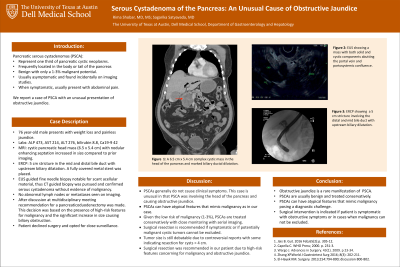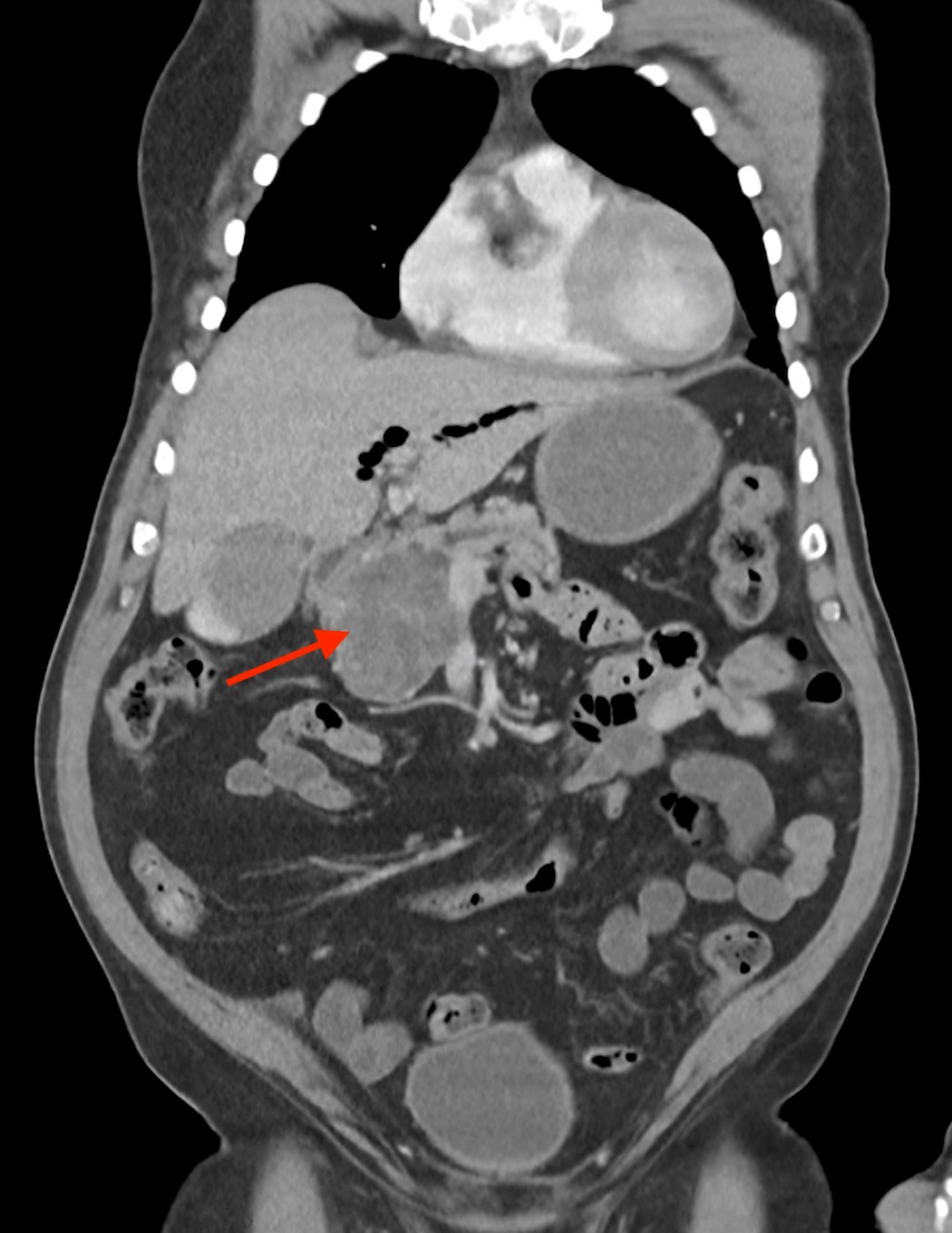Sunday Poster Session
Category: Biliary/Pancreas
P0060 - Serous Cystadenoma of the Pancreas: An Unusual Cause of Obstructive Jaundice
Sunday, October 22, 2023
3:30 PM - 7:00 PM PT
Location: Exhibit Hall

Has Audio

Rima Shobar, MD, MS
Dell Seton Medical Center at the University of Texas
Austin, TX
Presenting Author(s)
Rima Shobar, MD, MS1, Sagarika Satyavada, MD2
1Dell Seton Medical Center at the University of Texas, Austin, TX; 2Dell Medical School, Austin, TX
Introduction: Pancreatic serous cystadenomas (PSCA) represent one third of pancreatic cystic neoplasms. PSCAs are frequently located in the body or tail of the pancreas and are usually asymptomatic with a malignant potential < 3%. When symptomatic, they usually present with abdominal pain. We report a case of PSCA with an unusual presentation of obstructive jaundice.
Case Description/Methods: A 76 year-old male was admitted to our institution for an enlarging pancreatic head cystic lesion. He presented with weight loss and painless jaundice. Liver enzymes were elevated in a cholestatic pattern and CA19-9 was not elevated. MRI showed marked interval increase in size of cystic pancreatic head mass (6.5 x 5.4 cm) with nodular enhancing septation and marked biliary ductal dilatation compared to prior imaging. ERCP showed a 5 cm stricture involving the mid and distal bile duct with upstream biliary dilatation for which a metal stent was placed. On EUS, the mass had both solid and cystic components and was abutting the portal vein and porto-splenic confluence. EUS guided fine needle biopsy was notable for scant acellular material, thus CT guided biopsy was pursued and confirmed serous cystadenoma without evidence of malignancy. No abnormal lymph nodes or metastases were seen on CT or bone scan. The patient was discussed at a multidisciplinary meeting and recommendation for pancreaticoduodenectomy was made. This decision was based on the presence of high-risk features for malignancy and the significant increase in size causing biliary obstruction. Patient declined surgery and opted for close surveillance.
Discussion: Most PSCAs are asymptomatic and are detected as an incidental finding on imaging. This case highlights an unusual presentation of PSCA involving the head of the pancreas and causing obstructive jaundice. Given the low risk of malignancy (1-3%), PSCAs are treated conservatively with close monitoring with serial imaging. Surgical resection is recommended if symptomatic or if potentially malignant cystic tumors cannot be excluded. In one series, pathological examination failed to detect malignancy in 38%. Size of the tumor is still debatable since some reports indicate resection for cysts > 4 cm while others do not, given that the rate of growth did not correlate to initial size of tumor. In our patient, surgical resection was recommended because of high-risk features concerning for possible malignancy and obstructive jaundice.

Disclosures:
Rima Shobar, MD, MS1, Sagarika Satyavada, MD2. P0060 - Serous Cystadenoma of the Pancreas: An Unusual Cause of Obstructive Jaundice, ACG 2023 Annual Scientific Meeting Abstracts. Vancouver, BC, Canada: American College of Gastroenterology.
1Dell Seton Medical Center at the University of Texas, Austin, TX; 2Dell Medical School, Austin, TX
Introduction: Pancreatic serous cystadenomas (PSCA) represent one third of pancreatic cystic neoplasms. PSCAs are frequently located in the body or tail of the pancreas and are usually asymptomatic with a malignant potential < 3%. When symptomatic, they usually present with abdominal pain. We report a case of PSCA with an unusual presentation of obstructive jaundice.
Case Description/Methods: A 76 year-old male was admitted to our institution for an enlarging pancreatic head cystic lesion. He presented with weight loss and painless jaundice. Liver enzymes were elevated in a cholestatic pattern and CA19-9 was not elevated. MRI showed marked interval increase in size of cystic pancreatic head mass (6.5 x 5.4 cm) with nodular enhancing septation and marked biliary ductal dilatation compared to prior imaging. ERCP showed a 5 cm stricture involving the mid and distal bile duct with upstream biliary dilatation for which a metal stent was placed. On EUS, the mass had both solid and cystic components and was abutting the portal vein and porto-splenic confluence. EUS guided fine needle biopsy was notable for scant acellular material, thus CT guided biopsy was pursued and confirmed serous cystadenoma without evidence of malignancy. No abnormal lymph nodes or metastases were seen on CT or bone scan. The patient was discussed at a multidisciplinary meeting and recommendation for pancreaticoduodenectomy was made. This decision was based on the presence of high-risk features for malignancy and the significant increase in size causing biliary obstruction. Patient declined surgery and opted for close surveillance.
Discussion: Most PSCAs are asymptomatic and are detected as an incidental finding on imaging. This case highlights an unusual presentation of PSCA involving the head of the pancreas and causing obstructive jaundice. Given the low risk of malignancy (1-3%), PSCAs are treated conservatively with close monitoring with serial imaging. Surgical resection is recommended if symptomatic or if potentially malignant cystic tumors cannot be excluded. In one series, pathological examination failed to detect malignancy in 38%. Size of the tumor is still debatable since some reports indicate resection for cysts > 4 cm while others do not, given that the rate of growth did not correlate to initial size of tumor. In our patient, surgical resection was recommended because of high-risk features concerning for possible malignancy and obstructive jaundice.

Figure: Figure: CT Abdomen showing a multicystic heterogeneous pancreatic head mass
Disclosures:
Rima Shobar indicated no relevant financial relationships.
Sagarika Satyavada indicated no relevant financial relationships.
Rima Shobar, MD, MS1, Sagarika Satyavada, MD2. P0060 - Serous Cystadenoma of the Pancreas: An Unusual Cause of Obstructive Jaundice, ACG 2023 Annual Scientific Meeting Abstracts. Vancouver, BC, Canada: American College of Gastroenterology.
